external auditory canal
The external auditory canal (EAC) or external auditory meatus (EAM) extends from the lateral porus acusticus externus medially to the tympanic membrane.
Terminology
As the term external auditory meatus is variably used to refer to the canal itself or the porus acusticus externus (the round lateral opening), it may be better to use the term external auditory canal rather than meatus to avoid potential confusion.
Gross anatomy
The external auditory canal is typically 2.5 cm in length and is S-shaped.
The lateral one-third is bounded by a fibrocartilaginous tube continuous with the auricle . Defects in the cartilaginous part of the canal, which allow transmission of infection and malignancy, are known as fissures of Santorini.
The medial two-thirds is surrounded by bone. The anterior wall, floor, and lower part of the posterior wall arise from the tympanic part of the temporal bone . The roof and upper part of the posterior wall arise from the squamous part of the temporal bone . The skin of this inner part is directly applied to periosteum, with no subcutaneous tissue present. A normal variant defect in the anteroinferior aspect of the osseous part of the canal that connects with the temporomandibular joint is known as the foramen tympanicum (foramen of Huschke).
Boundaries
- medially
- superior: scutum
- middle: tympanic membrane
- inferior: tympanic annulus
- laterally: external auditory meatus surrounded by the pinna (auricle)
Contents
- arterial supply to the external ear: auricular branches derived from
- lymphatic vessels provide afferent drainage from the external ear
- pre- and post-auricular nodal groups
- parotid nodal group
- innervation to external and middle ear
Relations
- anteriorly: temporomandibular joint
- posteriorly: mastoid air cells
- superiorly: middle cranial fossa, superolateral mastoid air cells
- inferiorly: parotid space
Related pathology
- external auditory canal atresia
- external auditory canal exostoses (surfer's ear)
- external auditory canal osteoma
- otitis externa
Siehe auch:
und weiter:

 Assoziationen und Differentialdiagnosen zu Meatus acusticus externus:
Assoziationen und Differentialdiagnosen zu Meatus acusticus externus:


